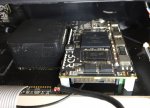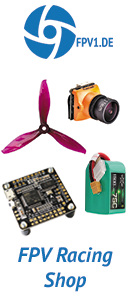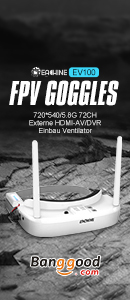Philip Rowse, (Übrigens einer der NEO7 Verfechter bei 3DR, so etwas gibt es tatsächlich...siehe auch SOLO oder C. Elder) hat Neues zum PIXHAWK 2 erzählt. Nicht ganz zufällig, denn Thomas Butler hat das 3DR Konzept zuvor in Frage gestellt und verschwand dann mitsamt Beiträgen in der Versenkung, was diydrones in Zensurverdacht brachte.. Ob das so war oder nicht, kann ich nicht sagen.
Zum PIXHAWK 2 : Wie wir (spätestens jetzt) alle wissen, ist nicht nur der kleine Würfel erforderlich, sondern auch ein Carrierboard (für Power/Ports usw.) da der PX 2 nicht alles enthält und lediglich einen 80Pin Connector bietet. Aus der Traum vom winzigen Standalone Zauberwürfel.
P.Rowse:
Anmerkungen 1:
1. Quite simple for anyone, ein 8 Layer Board.???.oh my gosh, aber man hat ja glücklicherweise vorab schon eine CN Fa. (Hobbyking?) kontaktiert, um für uns eine Lösung zu suchen. Bock zum Gärtner ? (Übersetzung für die Jüngeren unter uns: Nicht besonders schlau)
2. Der Hinweis auf den zu kleinen 1MB Flash, kam zwar schon öfter, weist in der erneuten Wiederholung aber umso deutlicher darauf hin, dass der PIXHAWK 1 sich EOL nähert. Der Code wird zukünftig noch mehr Speicherplatz erfordern.
Auf die Frage wann...
Anmerkungen 2:
Ich persönlich halte meine Herbst 2016 Vorhersage aufrecht. Ergo: Diesmal könnten manche CN Experten schneller sein, als 3DR selbst...z.B. CUAV, die mit dem PIXHACK von V1.71-2.01 deutliche Fortschritte gemacht haben sollen (Ob das stimmt, weiß ich in ein paar Wochen).
Quelle:
Im Original sind obige Quotes mit zukünftigen Reaktionen hier nachzulesen:
http://diydrones.com/forum/topics/p...forum&id=705844:Topic:1997263&page=7#comments
Zum PIXHAWK 2 : Wie wir (spätestens jetzt) alle wissen, ist nicht nur der kleine Würfel erforderlich, sondern auch ein Carrierboard (für Power/Ports usw.) da der PX 2 nicht alles enthält und lediglich einen 80Pin Connector bietet. Aus der Traum vom winzigen Standalone Zauberwürfel.
P.Rowse:
Hi All
Chris Anderson just pointed me to this thread.
My name is Philip Rowse, I am the lead Systems Engineer for 3DRobotics, and Hardware lead on the Pixhawk 2
All the files for Pixhawk 2 are available @ https://github.com/3drobotics/Pixhawk_OS_Hardware
In this folder you will also find instructions on how to download and install Altium, to view and search through the files.
I just had a look through Thomas's list, and will point out a few things...
1. We LOVE invensence there is 0 desire to get away from them. Their sensors rock!
there is 0 desire to get away from them. Their sensors rock!
2. The MS5611 is THE barometer of choice, as its accuracy is predictable.
3. The reason for a Baro on the baseboard and the IMU is for us to be able to study the effects of mounting, heating, and isolation strategies.
4. Isolation... Vibration is only 1 reason for isolating the IMU.
Temperature control, and mechanical strain are the most important.
5. Why the F4 rather than the F7? The F7 looks nice... But ST screwed up. The F7 is only available in a 1M flash size! If you look at both the Copter code and the PX4 flight stack, you can see that is a big concern moving forward.
6. The Flex IMU is attached to the FMU via a locking connector, and is removable, in fact, we have a few Devs planning on flying copters with just the FMU, and no External IMU... Nice and flexible.
7. The 80 pin... This is where controversy starts... And ends...
Trying to keep everyone happy on how connectors should work... Well, that's a loosing battle.
Pixhawk 1 was a connector farm. It allowed for everything, and as such needed to be massive.
With CAN ESC's just around the corner, we will soon see a day where a single 4 pin plug would be enough to get you off the ground...
Then there are OEM applications... Solo being a prime example... Where the new mounting method just makes sense.
For customers, we are looking at two options to start with, a full sized Pro, with more connectors than Pixhawk 1, and a mini, which still will get an Octo in the air, and will give a great idea as to the possibilities with future custom carrier boards!
To top that off, we have already sent the drawings for the carrier boards to a HK hobby supplier, to encourage them to build carrier boards to suit their airframes, rovers, boats etc...
Within the next couple of months I will be releasing the carrier board drawings in this same folder.
Oh, why Altium? Eagle is not suitable for doing 8 layer boards, and it's design rule functions are not as advanced as Eagle. However, I do intend on making an Eagle version of the carrier board reference design, as the carrier is quite simple for anyone to make. Don't be scared by the 80 pin connector, it is quite simple to solder in.
Any questions? PM, Drones Discuss, mumble... Raise an issue on the Git Repo where I put my drawings! That is my live working directory, that's where you will see future versions, and any mods...
For Solo we are currently building Rev D FMU, and Rev F IMU, rev E IM U is my experimental branch.
As far as this being a repackage... This is the beginning of a family of products.. Think about being able to update to the latest autopilot, without having to do any more than swap out a module... And for those into schematics... Can someone tell me, what are the inherent benefits of separating out the Power selection module from the Autopilot? Why might we have done this?
I hope this clears some stuff up.
...........
Chris Anderson just pointed me to this thread.
My name is Philip Rowse, I am the lead Systems Engineer for 3DRobotics, and Hardware lead on the Pixhawk 2
All the files for Pixhawk 2 are available @ https://github.com/3drobotics/Pixhawk_OS_Hardware
In this folder you will also find instructions on how to download and install Altium, to view and search through the files.
I just had a look through Thomas's list, and will point out a few things...
1. We LOVE invensence
2. The MS5611 is THE barometer of choice, as its accuracy is predictable.
3. The reason for a Baro on the baseboard and the IMU is for us to be able to study the effects of mounting, heating, and isolation strategies.
4. Isolation... Vibration is only 1 reason for isolating the IMU.
Temperature control, and mechanical strain are the most important.
5. Why the F4 rather than the F7? The F7 looks nice... But ST screwed up. The F7 is only available in a 1M flash size! If you look at both the Copter code and the PX4 flight stack, you can see that is a big concern moving forward.
6. The Flex IMU is attached to the FMU via a locking connector, and is removable, in fact, we have a few Devs planning on flying copters with just the FMU, and no External IMU... Nice and flexible.
7. The 80 pin... This is where controversy starts... And ends...
Trying to keep everyone happy on how connectors should work... Well, that's a loosing battle.
Pixhawk 1 was a connector farm. It allowed for everything, and as such needed to be massive.
With CAN ESC's just around the corner, we will soon see a day where a single 4 pin plug would be enough to get you off the ground...
Then there are OEM applications... Solo being a prime example... Where the new mounting method just makes sense.
For customers, we are looking at two options to start with, a full sized Pro, with more connectors than Pixhawk 1, and a mini, which still will get an Octo in the air, and will give a great idea as to the possibilities with future custom carrier boards!
To top that off, we have already sent the drawings for the carrier boards to a HK hobby supplier, to encourage them to build carrier boards to suit their airframes, rovers, boats etc...
Within the next couple of months I will be releasing the carrier board drawings in this same folder.
Oh, why Altium? Eagle is not suitable for doing 8 layer boards, and it's design rule functions are not as advanced as Eagle. However, I do intend on making an Eagle version of the carrier board reference design, as the carrier is quite simple for anyone to make. Don't be scared by the 80 pin connector, it is quite simple to solder in.
Any questions? PM, Drones Discuss, mumble... Raise an issue on the Git Repo where I put my drawings! That is my live working directory, that's where you will see future versions, and any mods...
For Solo we are currently building Rev D FMU, and Rev F IMU, rev E IM U is my experimental branch.
As far as this being a repackage... This is the beginning of a family of products.. Think about being able to update to the latest autopilot, without having to do any more than swap out a module... And for those into schematics... Can someone tell me, what are the inherent benefits of separating out the Power selection module from the Autopilot? Why might we have done this?
I hope this clears some stuff up.
...........
1. Quite simple for anyone, ein 8 Layer Board.???.oh my gosh, aber man hat ja glücklicherweise vorab schon eine CN Fa. (Hobbyking?) kontaktiert, um für uns eine Lösung zu suchen. Bock zum Gärtner ? (Übersetzung für die Jüngeren unter uns: Nicht besonders schlau)
2. Der Hinweis auf den zu kleinen 1MB Flash, kam zwar schon öfter, weist in der erneuten Wiederholung aber umso deutlicher darauf hin, dass der PIXHAWK 1 sich EOL nähert. Der Code wird zukünftig noch mehr Speicherplatz erfordern.
Auf die Frage wann...
The one thing I know... It's too early to promise.. But our intention is Christmas. Release to a very small group of Devs is in a couple of weeks...
What goes in the Christmas version will depend on feedback from this first group, as well as Solo users. every log from a solo owner is very useful in this process
What goes in the Christmas version will depend on feedback from this first group, as well as Solo users. every log from a solo owner is very useful in this process
Ich persönlich halte meine Herbst 2016 Vorhersage aufrecht. Ergo: Diesmal könnten manche CN Experten schneller sein, als 3DR selbst...z.B. CUAV, die mit dem PIXHACK von V1.71-2.01 deutliche Fortschritte gemacht haben sollen (Ob das stimmt, weiß ich in ein paar Wochen).
Quelle:
Im Original sind obige Quotes mit zukünftigen Reaktionen hier nachzulesen:
http://diydrones.com/forum/topics/p...forum&id=705844:Topic:1997263&page=7#comments




